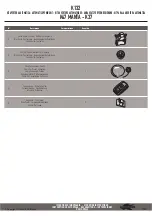
28
FEATURES AND CONTROLS
Brakes
Anti-Lock Brake System (ABS)
The anti-lock brake system automatically reduces or increases brake pressure as needed to
provide optimum braking control, reducing the chance of wheel lock-up during hard braking
events or when braking on rough, uneven, slippery or loose surfaces.
WARNING!
No stability control, traction control or anti-lock braking system can fully protect you from
every situation. Always be mindful of road conditions. Always drive safely and within the limits of the
driver, vehicle and road conditions.
WARNING!
Stability control, traction control and anti-lock braking systems rely on grip between the
tires and the road to function properly. In a hydroplane situation, tires lose contact with the road and the
effectiveness of these features may be diminished.
• The anti-lock brake system cannot be turned off.
• When the lamp is illuminated, the anti-lock brakes will not activate, but the conventional
brake system will continue to operate normally. See your dealer promptly for service.
• Operating with non-recommended tires or improper tire pressure may reduce the
effectiveness of the anti-lock brake system. Always use the recommended size and type of
tires specified for your vehicle. Always maintain the recommended tire pressure.
• The anti-lock brake system will not prevent wheel lockup, loss of traction or loss of
control
under all conditions.
Always adhere to all safe operating practices as
recommended.
• It is not unusual to leave tire marks on the road surface during a hard braking event.
• The anti-lock brake system does not compensate for or reduce the risks associated with:
• excessive speed
• reduced traction on rough, uneven or loose surfaces
• poor judgment
• improper operation
• hydroplaning
















































